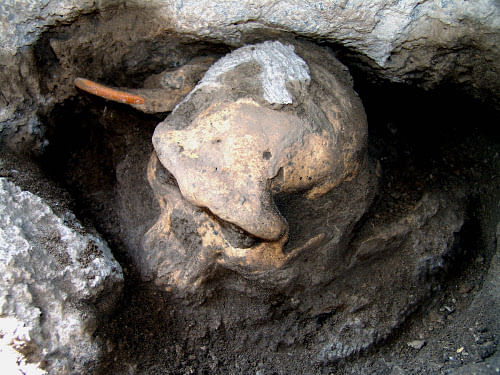
A well-preserved adult male skull, dating back to 1.8 million years ago, suggests that early man was a single species with individuals that could look quite different from each other.
The skull found in Dmanisi, Georgia is the most complete pre-human skull uncovered, researchers said.
The skull find has led scientists to conclude that specimens that were believed to represent several early human species may just be different-sized individuals from the same species.
Modern humans, Homo sapiens, are the only living member of the human lineage, Homo, believed to have been in Africa about 2 million years ago at the beginning of the Ice Age.
It has remained a puzzle whether there were several specialised Homo species in Africa at the time, at least one of which was able to spread outside of Africa or was there just one single species that was able to cope with a variety of ecosystems.
Researchers have proposed up to five contemporary species of early Homo in Africa, including Homo habilis, Homo rudolfensis, Homo ergaster and Homo erectus.
However, the new skull, with a small brain, large face and a massively built jaw, unites features that have been used previously as an argument for defining different African "species", researchers said.
It is the fifth skull to be discovered in Dmanisi. Previously, four equally well-preserved hominid skulls as well as some skeletal parts had been found there.
Researchers said the skull suggests that variation in Dmanisi can be compared with variation in modern human and chimpanzee populations.
"Firstly, the Dmanisi individuals all belong to a population of a single early Homo species. Secondly, the five Dmanisi individuals are conspicuously different from each other, but not more different than any five modern human individuals, or five chimpanzee individuals from a given population," said Christoph Zollikofer, anthropologist at the University of Zurich.
Diversity within a species is thus the rule rather than the exception, researchers said in the study published in the journal Science.
The present findings are supported by an additional study published in the journal PNAS.
In that study, Zollikofer and other colleagues show that differences in jaw morphology between the Dmanisi individuals are mostly due to differences in dental wear.
The findings set the date of departure of early human from Africa "much earlier" than thought.
They suggest Homo erectus evolved about 2 million years ago in Africa, and soon expanded through Eurasia - via places such as Dmanisi - as far as China and Java, where it is first documented from about 1.2 million years ago.
Deccan Herald is on WhatsApp Channels | Join now for Breaking News & Editor's Picks